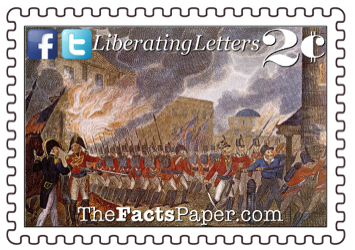Dolley Madison directed the refurnishing of the Executive Mansion, however, she and James never returned to it. They spent the rest of his term in the Octagon House, with the next president, James Monroe, occupying the new presidential home in 1817. To help rebuild the Library of Congress, Jefferson offered his personal collection of books for whatever price Congress offered. His library of almost 6,500 volumes more than doubled the collection lost in the fire.
Liberty, we are right now on the precipice of Washington being burned down again. Yet this time, it is being perpetrated by Americans within D.C. Likewise, the media is helping progressives destroy the sanctity of our flag as they prop up athletes kneeling for our national anthem. (see Hold The Fort and A Stitch In Time) As in Washington in 1814, progressive historians, politicians, and educators are setting America’s early history ablaze, this time by rewriting it and pushing a false narrative.
The New York Times recently announced their 1619 Project to do just that. (see The Color-Blindness Of Slavery) Pushing the complete lie that America was founded and built on slavery, their first official essay for the program claims “our democracy’s founding ideals were false when they were written.” So, everything our Founders wrote, even though they supposedly completely believed in what they were doing, lied about all of it. This is our world today, Liberty, where the truth is wrong and lies are facts. They have to do this because an honest look at our Founders’ words and the country’s actions prove their narrative for what is it, a festering pile of excrement. They can’t discount Jefferson’s condemnation of the king over slavery in the first draft of the Constitution or that the Founders outlawed slavery in the Northwest Territory, so their solution is to tell our children that those documents are lies. (see The Forgotten Midnight Ride and Charting A New Course)
Starting with the Tea Party movement in 2009, citizens began screaming the warnings of America losing her heritage. (see Tyrants And Tea Parties) Gathering in events across the nation, Patriots desperate to preserve the precious documents of our founding and past let their voices be heard. However, stubborn bureaucrats again refused to listen, just like Armstrong, and are still ignoring “We the People”. Yet like the strong sandstone framework of the White House and the Capital that remained after the fires, our country was founded on the solid rock of Divine Providence. (see God's Divine Providence) Our prayers must be that once again, God intervenes before our complete destruction, allowing His followers to rebuild America on her original foundation of “All Men Are Created Equal” before the progressive socialists and communists send us back to the involuntary servitude and slavery of 1619.
That’s my 2 cents.
Love,
Mom
August 24, 2019
Dear Liberty,
“What can we do to help?” asked Jacob Barker and Robert DePeyster as they rushed into the dining room.
“Save that picture if possible!” Dolley exclaimed knowing the Red Coats would relish destroying the 8-foot painting of George Washington by Gilbert Stuart. “Under no circumstances allow it to fall into the hands of the British!”
Losing precious time while her young slave, Paul Jennings, and the gardener, Thomas McGaw, tried to unscrew it from the wall, Dolley ordered them to break the frame and remove the canvass. However, the doorman, Jean “French John” Sioussat, hastily stopped the men believing it would damage the painting. Instead, with Dolley’s approval, he cut the linen from the frame with a penknife, which Barker and Depeyster gathered to hide from the British. Dolley fled the house to the sound of approaching troops as the aroma of the fleshly prepared evening meal penetrated the air.
No stranger to hardships, Dolley lost her first husband, John Todd, her in-laws, and a son during the yellow fever epidemic in Philadelphia in 1793. Under coverture law, married women at the time surrendered their right to own property or obtain a wage. They were also prevented from being executors of wills. Widowed at 25 and left with a son to raise and no job, Dolley needed money, of which John left her a small inheritance. However, his brother refused to give her the $19 (roughly $1400 in 2019) left to her in John's will, forcing her to sue to collect it. While Dolley lived through losing her family, could she survive the loss of her country, which her second husband was now president of?
Dolley performed hosting duties during widower Thomas Jefferson’s administration, which she continued as the official First Lady after her husband’s inauguration. A much taller figure than James Madison, Dolley instructed “Hail to the Chief” be played as he entered the dining room to lift up his short stature. As she took one last look at the room she hosted hundreds of dinners in, Dolley wondered if she would ever hear the tune played for James again.
In the early 1800s, Napoleon Bonaparte set out to conquer Britain. As the French and British battled in the Old World, they used the United States as a pawn in their real life game of Risk. As America remained neutral, continuing business with both countries, they both interfered in American trade with the opposing country. However Britain overreached, boarding American ships and capturing British defectors as well as native-born Americans. Though their fight wasn't with the United States, Britain pulled them into one, forcing Congress to sign a Declaration of War on June 18, 1812.
Fighting remained primarily confined to the Canadian-U.S. border until early 1814. Following Napoleon's first surrender and abdication in the spring of 1814, British resources, soldiers, and vessels were freed up and focus was placed fully on America. During the Battle of York on April 27, 1813, fought at Upper Canada’s capital of York (modern-day Toronto), the Americans set fire to multiple government buildings including the Government House and Parliament. Thoroughly embarrassed, it is believed Britain's attack on Washington D.C. was primarily retaliation more than anything else.
For weeks the British threatened to enter the decade old capital of the United States. The main structure of the Executive Mansion existed, known today as the White House, while the Capitol and other buildings were in various stages of completion. Even though many officials were concerned about the coming threat, Secretary of War John Armstrong adamantly rejected the possibility of a British invasion on Washington D.C. Convinced instead the Red Coats would descend on Baltimore, a much more prominent and military important city, Washington was left virtually defenseless as resources and men were sent elsewhere. Despite Armstrong's objections, citizens and younger statesmen qualified for the militia began fleeing the city.
As Secretary of State James Monroe (see Doctrinally Sound) watched the British in their march towards the capital, he quickly sent word to President Madison and his own staff to start acting regarding important documentation. Without a National Archives, each government department held the responsibility to preserve their important paperwork.
State Department clerks gathered vital and significant books and papers of the department, Congressional journals, Continental Congress papers including correspondence, treaties, and laws, and papers of George Washington. In addition, founding documents, the Declaration of Independence (see Happy Independence Day and The Forgotten Midnight Ride), the Constitution (see Constitution Day), and the Bill of Rights (see Ratifying Liberty), were bagged up in linen and placed on carts for evacuation.
A handful of clerks in the House and Senate swiftly began collecting important papers a few days before the British arrival. Unfortunately, they found it hard to secure carts and oxen as 90% of residents were already gone or fleeing with all available means of travel. Armstrong's stubborn refusal to heed the warnings prevented the preservation of a valuable portion of America's heritage.
Meanwhile, at the Executive Mansion, Dolley Madison gathered what national treasures she could find while dismissing her own personal items. In a letter started on August 23, 1814, Dolley chronicled her events to her sister stating, “I have since received two despatches [sic] from him (James), written with a pencil. The last is alarming, because he desires I should be ready at a moment's warning to enter my carriage, and leave the city.” President Madison, as well as Dolley, were well aware of the British’s desire to capture the president's wife and parade her through the streets of London as a prison of war. Dolley explained that she “pressed as many Cabinet papers into trunks as to fill one carriage; our private property must be sacrificed, as it is impossible to procure wagons for its transportation.”
The following afternoon, she recorded: “Will you believe it, my sister? We have had a battle, or skirmish, near Bladensburg, and here I am still, within sound of the cannon! Mr. Madison comes not. May God protect us! Two messengers, covered with dust, come to bid me fly; but here I mean to wait for him. . . At this late hour a wagon has been procured, and I have had it filled with plate and the most valuable portable articles, belonging to the house.”
Ending her letter with uncertainty, Dolley declared, “And now, dear sister, I must leave this house, or the retreating army will make me a prisoner in it by filling up the road I am directed to take. When I shall again write to you, or where I shall be tomorrow, I cannot tell!”
Dolley met James at a predetermined location as the British entered the capital at dusk. Focusing primarily on government buildings, the evening sky was illuminated by the glow of America’s early history going up in flames. However, when the British entered the Executive Mansion, they discover the table set and ready for an evening dinner party. As many of the men had not enjoyed a decent, home cooked meal in months, or even years, they delighted in a hardy feast on fine china before torching their hosts’ home as they left.
By the end of the evening of August 24, 1814, in addition to the Executive Mansion, the British vandalized and set fire to the unfinished Capitol Building, which contained the Senate and House of Representatives chambers as well as the Library of Congress and the Supreme Court. In the Library alone, roughly three thousand rare books were incinerated. Other government buildings destroyed included the Departments of State, War, and Navy, and the Treasury Building. The only government building untouched was the U.S. Patent Office. Former Architect of the Capitol, William Thornton, who was now the Superintendent of Patents, convinced the British not to destroy the hundreds of inventions of the citizens housed within. The Washington Navy Yard was also destroyed, but by the Americans in order to prevent the British from capturing the supplies, ships, and ammunition contained within.
The only targeted non-government building was the home of the National Intelligencer newspaper. Infuriated by unflattering articles about him, British Admiral George Cockburn ordered it demolished brick by brick as local women persuaded him not to burn it out of fear of the flames spreading to their homes.
The following morning, the British returned to the smoldering remains to rekindle the fires. They were determined to leave the city in complete ashes. However, Divine Providence intervened, sending a violent storm, possibly a hurricane, over the city that had not seen rain in over three weeks. (see God’s Divine Providence) Any remaining flames or smoking embers were extinguished by the powerful rains as the high winds generated a very rare tornado in the city. After roughly 26 hours in the capital, the British left once the storm interrupted their efforts.
A month after the British invaded and burned Washington, they started their attack on Baltimore as Armstrong predicted. Throughout the night of September 13, 1814, the Royal Navy bombarded Fort McHenry, yet the Patriots fought them off. The following morning, Francis Scott Key watched the Stars and Stripes wave in the wind over the fort, inspiring the poem which became “The Star-Spangled Banner.” (see Hold The Fort) Also known as "Madison's War" and the "Second War of Independence," the War of 1812 ended the following Christmas Eve with the Treaty of Ghent.
Most agree the British never meant to occupy Washington D.C., only to raze it, partly out of revenge and partly to discourage the Americans. Therefore, while many believe Providence sent the storm to save Washington, others argue it changed nothing. When Congress returned a few days later, they considered moving the capital seeing its vulnerable position and obvious destruction. However, the decision to stay triumphed by a very narrow margin. One wonders, had the British succeeded in completely flattening the city’s government buildings, would the vote to move have succeeded. Over the next four years, the capital was rebuilt around the skeletons of the surviving buildings. Despite the intense heat of the fires, the thick sandstone walls of the Executive Mansion and Capitol remained standing.
BURNING DOWN
THE HOUSE





